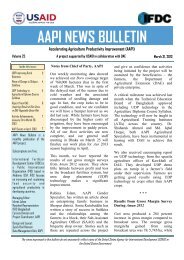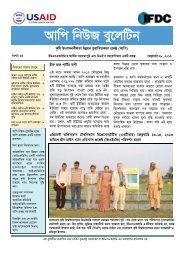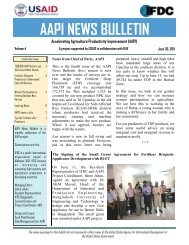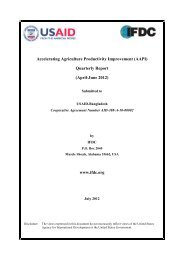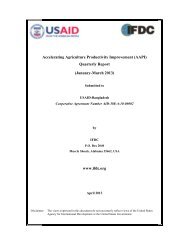AAPI 8th Quarterly Report Jul-Sept 2012
AAPI 8th Quarterly Report Jul-Sept 2012
AAPI 8th Quarterly Report Jul-Sept 2012
Create successful ePaper yourself
Turn your PDF publications into a flip-book with our unique Google optimized e-Paper software.
of jobs for part-time employees was calculated by dividing the total number of months<br />
worked by 12 months per year, as per FTF definition. Part-time employees were counted if<br />
they worked at least one month on a continuous basis.<br />
As explained last quarter (QPR 7, April-June <strong>2012</strong>), it is estimated that each business<br />
creates 1.67 jobs. This is the number now used by <strong>AAPI</strong> and the achievements in Table 2. In<br />
the census reported last quarter, it was found that 99 percent of the jobs are male (99 percent<br />
in M&S; 98 percent in FTF districts).<br />
Number of Individuals Receiving Short-Term Training<br />
This is an FTF Indicator. It was only introduced in Quarter 7 and therefore has no<br />
targets set. The data in Table 2 for Year 1 and earlier quarters have been calculated from the<br />
composite parts. The number of individuals who have received short-term training is<br />
calculated from farmer training, training of briquette machine owners, training of government<br />
staff and NGOs (training of trainers [TOT]) and training of local mechanics.<br />
Increased Yield of Rice<br />
The incremental yield arising from UDP technology is derived from crop cuts in<br />
farmer fields. At the time of the Aus harvest, 416 crop cuts were made in farmer fields (345 in<br />
FTF and 71 in M&S). Each cut was actually two samples, one within a UDP field and one<br />
(nearby) within a broadcast urea field with the same variety and soil type. The samples were<br />
threshed, weighed and grain moisture measured. Yield is calculated as kg paddy/ha, adjusted<br />
to a moisture content of 14 percent. Paddy yield is converted to rice yield by assuming a mill<br />
out of 67 percent. Targets assumed rice yield increments of 535 kg/ha in Aus and Aman and<br />
670 kg/ha in Boro. Table 9 shows the yield increment for the HYV varieties.<br />
16



